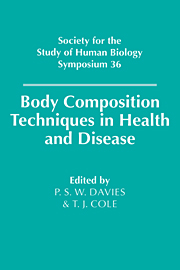Book contents
- Frontmatter
- Contents
- List of contributors
- 1 Application of dual-energy X-ray absorptiometry and related techniques to the assessment of bone and body composition
- 2 In vivo neutron activation analysis: past, present and future
- 3 Magnetic resonance imaging for the assessment of body composition
- 4 Multi-frequency impedance as a measure of body water compartments
- 5 Body composition assessed by electrical conductivity methods
- 6 Body composition in malnutrition
- 7 Influence of body composition on protein and energy requirements: some new insights
- 8 Prediction of adult body composition from infant and child measurements
- 9 Assessment of body composition in the obese
- 10 The role of body physique assessment in sports science
- 11 The assessment of the body composition of populations
- 12 Changes in approach to the measurement of body composition
- 13 Multi-compartment models for the assessment of body composition in health and disease
- 14 The future of body composition research
- Index
3 - Magnetic resonance imaging for the assessment of body composition
Published online by Cambridge University Press: 18 September 2009
- Frontmatter
- Contents
- List of contributors
- 1 Application of dual-energy X-ray absorptiometry and related techniques to the assessment of bone and body composition
- 2 In vivo neutron activation analysis: past, present and future
- 3 Magnetic resonance imaging for the assessment of body composition
- 4 Multi-frequency impedance as a measure of body water compartments
- 5 Body composition assessed by electrical conductivity methods
- 6 Body composition in malnutrition
- 7 Influence of body composition on protein and energy requirements: some new insights
- 8 Prediction of adult body composition from infant and child measurements
- 9 Assessment of body composition in the obese
- 10 The role of body physique assessment in sports science
- 11 The assessment of the body composition of populations
- 12 Changes in approach to the measurement of body composition
- 13 Multi-compartment models for the assessment of body composition in health and disease
- 14 The future of body composition research
- Index
Summary
Introduction
Body composition assessment has become of great importance in evaluating physiological and pathological states. In obesity research estimation of total-body fat and fat regional distribution are considered an important goal both in adults and in children. In fact, the morbidity risk of obesity has been clearly related to the amount of total-body fat and, more strongly, to visceral adiposity (Krotkiewsky et al., 1983,; Peiris et al., 1989). Consequently the validation of different techniques for body composition analysis has become of great importance. New methods have been added to old ones, but it is still hard to define the optimum in fulfilling all the necessary criteria. This is particularly true for children, where ethics, accuracy and acceptable cost are fundamental. In Table 3.1 some of the available techniques are rooted according to these characteristics: none of them fully satisfies our criteria and only a few can discriminate body fat distribution.
Magnetic resonance imaging (MRI) has recently been proposed for assessing fat content and distribution in both adults and children. This technique may supersede computed tomography (CT) scanning and therefore avoid ionising radiation exposure. Table 3.1 identifies MRI as ideal in terms of ethics and precision, but its high cost limits its use to selected populations.
MRI technique is based on the interaction between the nuclei of hydrogen atoms, which occur abundantly in all biological tissues, and the magnetic field, 10,000 times stronger of that of the Earth, generated by the MRI system. When a subject is placed inside the field, protons tend to align themselves with the field. A radiofrequency pulse is then applied to the system causing an absorption of energy.
- Type
- Chapter
- Information
- Body Composition Techniques in Health and Disease , pp. 38 - 44Publisher: Cambridge University PressPrint publication year: 1995



